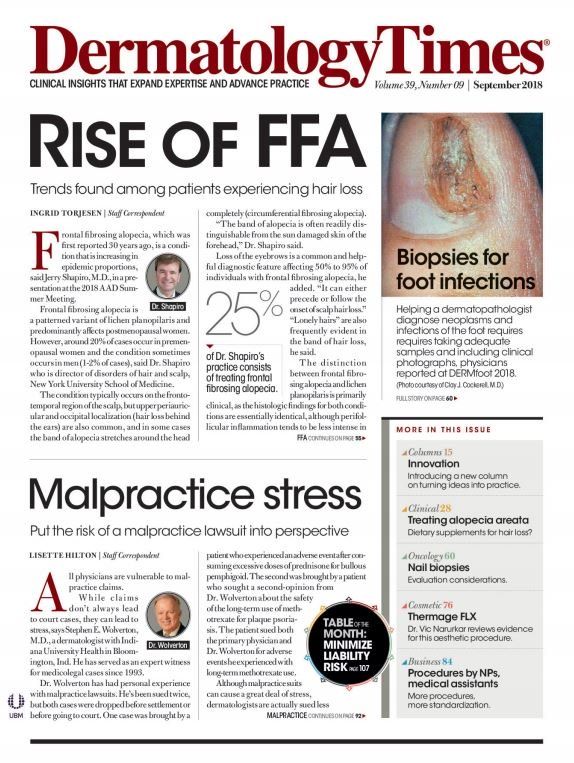- Acne
- Actinic Keratosis
- Aesthetics
- Alopecia
- Atopic Dermatitis
- Buy-and-Bill
- COVID-19
- Case-Based Roundtable
- Chronic Hand Eczema
- Chronic Spontaneous Urticaria
- Drug Watch
- Eczema
- General Dermatology
- Hidradenitis Suppurativa
- Melasma
- NP and PA
- Pediatric Dermatology
- Pigmentary Disorders
- Practice Management
- Precision Medicine and Biologics
- Prurigo Nodularis
- Psoriasis
- Psoriatic Arthritis
- Rare Disease
- Rosacea
- Skin Cancer
- Vitiligo
- Wound Care
Publication
Article
Dermatology Times
Innovation matters in dermatology
Introducing a new column called "Innovation" from the co-founders of Advancing Innovation in Dermatology Accelerator Fund. In the first installment of this series, Drs. Steve Xu and William Ju address the importance of innovation in dermatology.
Introducing a new column called "Innovation" from the co-founders of Advancing Innovation in Dermatology Accelerator Fund. In the first installment of this series, Drs. Steve Xu and William Ju address the importance of innovation in dermatology. (©LoveTheWind/Shutterstock.com)

Dr. Xu

Dr. Ju

Dermatology is a small field, however, from an innovation standpoint, we have always felt that dermatology punches way above its weight1.
Over the last 20 years, the increased knowledge of the underlying pathophysiology of skin diseases has led to critical insights that have yielded new therapeutic options:
• Our field continues to be at the forefront of clinical immunology with new targeted biologics providing dramatic disease responses for patients with serious inflammatory skin conditions.
• In oncology, melanoma and Merkel cell carcinoma are focus points in cancer immunotherapy.
• Non-invasive fat reduction, and laser/light and other energy-based products are bright spots in medical device innovation.
• Breakthrough advances in gene therapy and stem cell science hold great promise in treating fatal blistering diseases.
• Botulinum toxin and fillers, driven forward by dermatologists2, have fueled the increasing demand for non-invasive aesthetic treatments.
• Finally, artificial intelligence and other health IT tools have already entered our field in meaningful ways.
While there are many developments to be excited about and celebrate, biomedical innovation is always tenuous. Innovation needs to be continuously supported and nurtured because it can be easily extinguished. Aligning science, funding, and market opportunity requires exceptional individuals and often â some luck.
Innovation is vulnerable. This is especially true in dermatology. We are a field with few common diseases and many rare ones. Advancing care for orphan conditions is at risk for stagnation. One in four Americans will see a physician for a skin problem this year, and a study from American Academy of Dermatology shows that of 24 skin disease categories analyzed, half are associated with mortality3. Biomedical innovation is a critical source of progress and differentiation for our specialty and our patients.
This new column in Dermatology Times will focus on a broad scope of issues related to innovation in dermatology. The first objective is to provide practical, actionable advice and knowledge resources for individuals that have an interest in pursuing their own innovations in our field, either by themselves or as part of teams. These articles will focus on key steps along the product innovation journey. For instance, we will explore the science behind problem identification and needs statements. Intellectual property and technology transfer issues will be discussed supplemented by experts opinions. Other topics include fundraising and regulatory hurdles. The second objective is to provide a broader assessment of innovation in dermatology and how new global developments in our space will (or will not) improve patient care. The third is to simply tell stories that show innovation can be driven by individuals4. It is our hope these stories serve both as inspiration and education.
As we look to the future, how do we cultivate an ecosystem that recognizes and overcomes the scientific, clinical, and economic challenges that face innovation in dermatology? It is our belief that our field be a model for other specialties in medicine by cultivating patient-centric innovation by engaging in a wide-range of stakeholders.
ABOUT THE AUTHORS: Dr. Xu is an instructor in dermatology at Northwestern University Feinberg School of Medicine; medical director, Center for Bio-Integrated Electronics, Simpson Querrey Institute for Bionanotechnology, Northwestern University; and, co-founder, Advancing Innovation in Dermatology Accelerator Fund
Dr. Ju is co-founder of Advancing Innovation in Dermatology, Inc. and co-founder of the Advancing Innovation in Dermatology Accelerator Fund
DISCLOSURES:
All authors are members of Advancing Innovation in Dermatology, Inc., a registered 501(c)(3) organization designated as a public charity in the United States.
CITATIONS:
1) Shuai Xu, MD; Jamie Breslin, PhD; William Ju, MD. "Catalyzing Future Drug, Device, and Information Technology Breakthroughs in Dermatology. Announcing Advancing Innovation in Dermatology’s Accelerator Fund," JAMA Dermatology. May 2018. DOI:10.1001/jamadermatol.2018.0590
2) Bangash, Haider K. MD; Eisen, Daniel B. MD; Armstrong, April W. MD; et al. "Who are the Pioneers? A Critical Analysis of Innovation and Expertise in Cutaneous Noninvasive and Minimally Invasive Cosmetic and Surgical Procedures," Dermatologic Surgery. March 2016. DOI:10.1097/DSS.0000000000000661
3) Henry W. Lim, MD; Scott A.B. Collins, MD; Jack S. Resneck Jr., MD; et al. "The burden of skin disease in the United States," JAAD. May 2017. DOI:https://doi.org/10.1016/j.jaad.2016.12.043
4) Xu S, Kesselheim AS. "Medical innovation then and now: Perspectives of innovators responsible for transformative drugs," The Journal of Law, Medicine and Ethics. Winter 2014. DOI:10.1111/jlme.12176.

Newsletter
Like what you’re reading? Subscribe to Dermatology Times for weekly updates on therapies, innovations, and real-world practice tips.



















